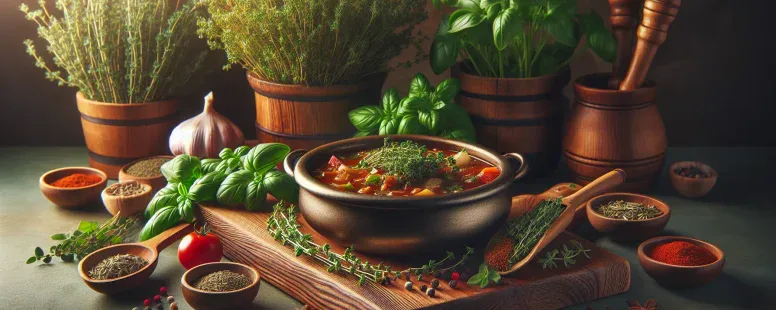Top 7 Substitute Options for Bay Leaf to Enhance Your Recipes
The aroma of a simmering stew or hearty soup often feels incomplete without the subtle, earthy touch of bay leaves. But what happens when you reach for that trusty little leaf and realize you’re out? Don’t worry—you’re not stuck with a flavorless dish. There are plenty of creative substitutes that can step in and deliver just as much depth and complexity to your cooking.
What Is A Bay Leaf?
A bay leaf is an aromatic leaf commonly used in cooking to add flavor to broths, soups, and sauces. Derived from the bay laurel tree (Laurus nobilis), these leaves are typically dried before use but can also be used fresh in some dishes.
Bay leaves have a subtle, earthy taste with hints of floral and herbal notes. When simmered during cooking, they release a complex aroma that enhances the dish’s overall flavor profile without overpowering it. You often remove them before serving as their texture remains tough even after long cooking times.
Commonly associated with Mediterranean cuisine, bay leaves are also widely used in Indian curries, French stews like bouillabaisse, and Caribbean spiced dishes such as jerk chicken. While you might not eat a bay leaf directly due to its tough texture and sharp edges, its contribution lies in infusing layers of depth into recipes.
Plus to their culinary value, bay leaves have historical significance. Ancient Greeks and Romans considered them a symbol of victory and honor; laurel wreaths were crafted from the same plant for athletes and leaders alike.
Why Look For A Substitute For Bay Leaf?
Bay leaves, while flavorful and aromatic, may not always be available in your kitchen. You might run out unexpectedly or discover that their unique taste doesn’t appeal to everyone’s palate. In such cases, finding a substitute ensures that your dish retains its intended depth without compromise.
Some people prefer substitutes due to dietary restrictions or allergies associated with certain plants. Although bay leaves are generally safe, individual sensitivities highlight the need for alternatives. Also, if you’re experimenting with new cuisines or flavors, replacing bay leaves allows you to tailor recipes based on personal preferences.
Availability can also be an issue. If fresh or dried bay leaves aren’t accessible in local stores or during travel, substitutes like thyme, oregano, or even basil (in Italian dishes) can replicate similar herbal notes effectively.
Finally, cooking styles play a role; some recipes benefit more from spices like cinnamon sticks than traditional bay leaves when enhancing sweetness and warmth in stews.
Top Substitute Options For Bay Leaf
When you’re out of bay leaves, several substitutes can replicate their earthy and aromatic qualities. Each option works best in specific dishes, ensuring your recipes lose none of their depth.
Dried Thyme
Dried thyme provides a subtle, woodsy flavor similar to bay leaves. It’s ideal for soups, stews, and roasted meats. Use 1/4 teaspoon of dried thyme for every bay leaf in the recipe. For example, a beef stew benefits from thyme’s herbal notes without overpowering other ingredients.
Basil
Basil offers sweetness and a slightly peppery undertone that works well in Italian or Mediterranean dishes. Fresh basil is better suited for sauces like marinara or tomato-based broths. Add two fresh basil leaves as a substitute or use 1/2 teaspoon of dried basil when cooking pasta sauces.
Oregano
Oregano delivers robust herbal flavors with slight bitterness, making it perfect for hearty dishes like chili or casseroles. Replace one bay leaf with 1/3 teaspoon of oregano to enhance savory recipes. Its bold profile pairs well with tomatoes and beans.
Marjoram
Marjoram resembles mild oregano but has sweeter citrus notes. This substitute complements poultry dishes, creamy soups, or vegetable stews. Use 1/4 teaspoon of marjoram per bay leaf to achieve an aromatic balance without overwhelming lighter flavors.
Rosemary
Rosemary’s pine-like aroma and strong flavor make it suitable for roasts or grilled vegetables but less effective in delicate broths. Substitute one small sprig of rosemary for each bay leaf when preparing lamb dishes or hearty pot roasts to add depth and warmth.
Choosing The Best Substitute For Your Dish
Selecting a suitable bay leaf substitute depends on your dish’s flavor profile. Each replacement offers unique characteristics that can enhance specific recipes.
- Dried Thyme
Dried thyme works well in soups and stews. Its earthy, slightly minty flavor mimics bay leaves’ depth. Use ½ teaspoon of dried thyme for every bay leaf required.
- Oregano
Oregano complements hearty dishes like chili or tomato-based sauces. Replace one bay leaf with ¼ teaspoon of oregano for balanced herbal notes.
- Basil
Basil fits Italian and Mediterranean cuisine perfectly, adding a sweet yet peppery undertone similar to bay leaves. Sub in one fresh basil leaf or ½ teaspoon dried basil per bay leaf.
- Marjoram
Marjoram is ideal for poultry dishes and creamy soups due to its mild sweetness and citrus hints. Use equal amounts as a replacement—1 bay leaf equals 1 marjoram sprig or ½ teaspoon dried marjoram.
- Rosemary
Rosemary suits roasts and savory baked dishes with its robust pine-like aroma but may overpower delicate broths if used excessively. Start with half the quantity (¼ teaspoon) when substituting rosemary for a single bay leaf.
When choosing substitutes, consider their potency; some herbs are stronger in flavor than others, requiring smaller amounts to avoid overwhelming the dish’s taste balance.
Tips For Using Bay Leaf Substitutes
Adjust quantities carefully. Bay leaf substitutes often have stronger or milder flavors than bay leaves. For instance, thyme and oregano are more potent, so use smaller amounts to avoid overpowering your dish.
Match the substitute to the recipe’s flavor profile. Use herbs like basil for Mediterranean dishes and marjoram for creamy soups or poultry recipes. Choose cinnamon sticks or cloves when aiming for warmth in stews.
Test substitutes before finalizing a dish. Add small amounts of your chosen alternative gradually during cooking, tasting as you go, to ensure it complements other ingredients without clashing.
Consider fresh versus dried forms. Fresh herbs like basil provide brighter flavors compared to their dried counterparts, which offer concentrated aromatic qualities better suited for slow-cooked recipes.
Balance multiple substitutes if needed. Combine rosemary with thyme to mimic bay leaves’ complexity in hearty broths or casseroles while avoiding dominance by either herb.
Remove robust spices after simmering when using alternatives like cinnamon sticks or cloves; leaving them too long may result in overly strong flavors that mask subtler notes in your recipe.
Conclusion
Running out of bay leaves doesn’t have to disrupt your cooking. With a range of suitable substitutes available, you can still achieve the nuanced flavors and aroma they bring to your dishes. Whether you lean towards thyme, oregano, or even cinnamon sticks for a unique twist, there’s always an option to match your recipe’s needs.
Experimenting with these alternatives gives you the chance to discover new flavor combinations while maintaining balance in your meals. By carefully adjusting quantities and considering the dish’s overall profile, you’ll continue creating flavorful soups, stews, and sauces that impress every time.
- Understanding the Difference Between Yield and Return: Key Insights for Investors - October 1, 2025
- Key Differences Between Saving and Checking Accounts: Which Is Right for You? - October 1, 2025
- Top 7 Substitute Options for Bay Leaf to Enhance Your Recipes - October 1, 2025







